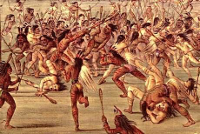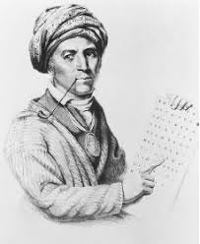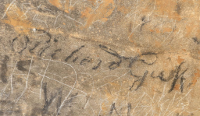|
Cave Wall Messages Written in Cherokee Language
April 10, 2019
The messages, some of which were written backward, appear on the wall of Manitou Cave, near what was then Willstown but is now Fort Payne. Some of the messages were appeals to supernatural forces to aid the Cherokee's efforts in a contest of stickball, a prime sport preferred by the Native American tribe most famous for embarking on the Trail of Tears. Archaeologists know that the messages were put on the wall on April 30, 1828 because one of the messages contains that date. That was not long before the advent of the Indian Removal Act, which stipulated that the Cherokee and other tribes would have to give up their ancestral lands and head west. The sport of stickball was similar to lacrosse and involved multi-day competitions of sometimes violent contests that took the place of battles and wars. Rules were few and referees nonexistent. Action was constant, and substitutions were not allowed. The ball was a rock covered with an inner layer of hair and an outer layer of hide, similar to a baseball. Competitors used two sticks of wood, usually hickory, to throw the ball, which is held in a wooden webbing at the head of one of the sticks. Great ceremonies preceded competitions, involving dance and prayers. The great Cherokee leader Sequoyah (right), who lived nearby, created his alphabet in 1821. More properly known as a syllabary because it is 85 characters based on the syllables of the Cherokee language. The Cherokee accepted it as official in 1825, just three years before the newly identified cave wall messages were written. The Cherokee Phoenix, a Native American newspaper, was published in this alphabet in February 1828. Just a few months later, a group of Cherokee went into the Willstown-area cave and painted the messages now being studied. One message bears the signature of Sequoyah's son. A historian and photographer recognized the writing in 2006 and showed a photo of the writing to University of Tennessee-Knoxville archaeologist Jan Simek, who initially could not investigate because the cave, which was on private land, changed hands and the new owner would not allow anyone else in there. That owner sold the cave in 2015, and the new owner has allowed investigation to take place. |
|
Social Studies for Kids
copyright 2002–2024
David White



 Archaeologists have confirmed that Cherokee gathered in an Alabama cave 200 years ago and wrote ceremonial messages using their newly created alphabet.
Archaeologists have confirmed that Cherokee gathered in an Alabama cave 200 years ago and wrote ceremonial messages using their newly created alphabet.



